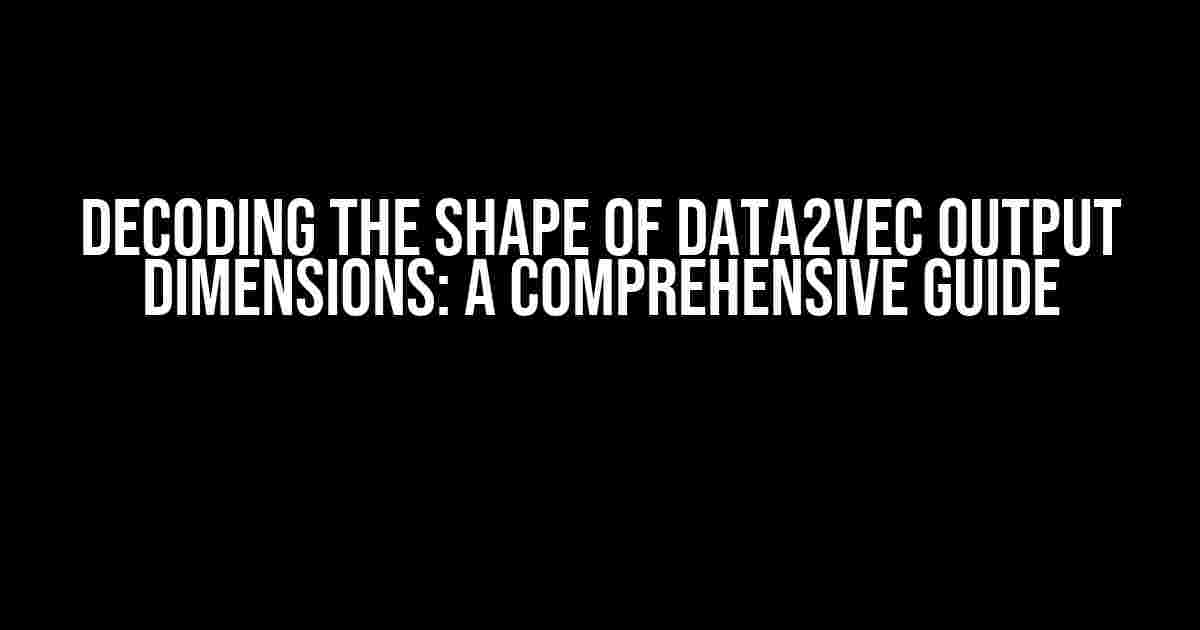Are you struggling to understand the output dimensions of Data2Vec, a popular self-supervised learning framework? Do you find yourself lost in a sea of vectors and matrices? Fear not, dear reader, for we’re about to embark on a thrilling adventure to demystify the shape of Data2Vec output dimensions.
What is Data2Vec?
Data2Vec is a powerful framework that enables self-supervised learning for various types of data, including images, text, and audio. It allows models to learn representations from unlabeled data, which can then be fine-tuned for specific downstream tasks. But, with great power comes great complexity, and understanding the output dimensions of Data2Vec is crucial for harnessing its potential.
The Basics of Data2Vec Output Dimensions
In Data2Vec, the output dimensions are typically represented as a 3-dimensional tensor, denoted as (B, N, D), where:
- B: Batch size, representing the number of samples in the batch
- N: Sequence length, representing the number of tokens or features in the input data
- D: Embedding dimension, representing the number of features in the output representation
This 3-dimensional tensor contains the output representations for each sample in the batch, where each representation is a vector of length D.
Understanding the Shape of Data2Vec Output Dimensions
To better comprehend the shape of Data2Vec output dimensions, let’s dive deeper into each component:
Batch Size (B)
The batch size (B) represents the number of samples processed in parallel during training or inference. In other words, it’s the number of input samples that are grouped together to form a single batch. A larger batch size can provide better computational efficiency, but may also increase memory usage.
import torch
batch_size = 32
input_data = torch.randn(batch_size, 224, 224, 3) # (B, H, W, C)Sequence Length (N)
The sequence length (N) represents the number of tokens or features in the input data. For example, in natural language processing, N might represent the number of words in a sentence. In computer vision, N might represent the number of pixels in an image.
import torch
sequence_length = 256
input_data = torch.randn(1, sequence_length, 128) # (B, N, D)Embedding Dimension (D)
The embedding dimension (D) represents the number of features in the output representation. This is the dimensionality of the vector space where the input data is projected. A larger embedding dimension can capture more complex relationships between the input features, but may also increase the risk of overfitting.
import torch
embedding_dim = 128
input_data = torch.randn(1, 256, embedding_dim) # (B, N, D)Visualizing Data2Vec Output Dimensions
To better visualize the shape of Data2Vec output dimensions, let’s consider a concrete example:
| Batch Size (B) | Sequence Length (N) | Embedding Dimension (D) |
|---|---|---|
| 32 | 256 | 128 |
In this example, the output dimensions would be (32, 256, 128), representing a batch of 32 samples, each with a sequence length of 256, and an embedding dimension of 128.
Practical Applications of Data2Vec Output Dimensions
Now that we’ve demystified the shape of Data2Vec output dimensions, let’s explore some practical applications:
-
Text Classification: In text classification tasks, the output dimensions might be (B, N, D), where B is the batch size, N is the sequence length (number of words in a sentence), and D is the embedding dimension. The output representation can be used as input to a classifier to predict the sentiment or topic of the text.
-
Image Classification: In image classification tasks, the output dimensions might be (B, H, W, D), where B is the batch size, H and W are the height and width of the image, and D is the embedding dimension. The output representation can be used as input to a classifier to predict the class label of the image.
-
Audio Classification: In audio classification tasks, the output dimensions might be (B, T, D), where B is the batch size, T is the sequence length (number of audio frames), and D is the embedding dimension. The output representation can be used as input to a classifier to predict the class label of the audio.
Conclusion
In conclusion, understanding the shape of Data2Vec output dimensions is crucial for harnessing its potential in self-supervised learning. By grasping the concepts of batch size, sequence length, and embedding dimension, you can unlock the secrets of Data2Vec and apply it to various applications. Remember, with great power comes great responsibility, so use your newfound knowledge wisely!
Still have questions or need further clarification? Feel free to ask in the comments below!
Additional Resources
- PyTorch Documentation: nn.Module
- Data2Vec: A Framework for Self-Supervised Learning
- PyTorch Tutorial: Data2Vec
Frequently Asked Question
Get the inside scoop on Data2Vec output dimensions!
What is the shape of Data2Vec output dimensions?
The output dimensions of Data2Vec are typically in the shape of (sequence_length, hidden_size). The sequence_length represents the number of tokens in the input sequence, and the hidden_size is the dimensionality of the output vector for each token.
Can I adjust the output dimensions of Data2Vec?
Yes, you can adjust the output dimensions of Data2Vec by tweaking the model architecture or using techniques like pooling or flattening. However, be careful when making changes, as they might affect the model’s performance.
How does the output dimensionality of Data2Vec compare to other transformer-based models?
Data2Vec’s output dimensions are similar to those of other transformer-based models, such as BERT and RoBERTa. However, Data2Vec’s output dimensions can be adapted to specific tasks or datasets, whereas other models might have fixed output dimensions.
What are some common applications that require adjusting the output dimensions of Data2Vec?
Applications that require adjusting the output dimensions of Data2Vec include computer vision tasks, speech recognition, and multitask learning. In these cases, adjusting the output dimensions can help improve model performance or adapt to specific task requirements.
Are there any pre-trained Data2Vec models with customized output dimensions?
Yes, there are pre-trained Data2Vec models with customized output dimensions available, such as models fine-tuned for specific tasks or domains. You can explore model repositories or community-driven platforms to find pre-trained models that suit your needs.


